Food and what it contains is essentially a simple discussion for us hardline whole-foodies – the only truly nourishing meals we prefer are plant-only, whole, and minimally processed creations that we mostly make ourselves. But what if we chose to consume a commercially made probiotic or a soy sauce perhaps? Would you be bothered about its level of bacillus subtilis or whether it had been genetically modified?
Over the last few years, this spore-forming bacterium has gained recognition for its versatile applications in various industries, including food, agricultural, and pharmaceutical sectors. Known for its ability to secrete a wide range of enzymes and exhibit antimicrobial activity, Bacillus subtilis is commonly used as a processing aid.
Perhaps because it is so common there has been little concern over its inclusion in a wide range of products and applications. Still, one paper published on sciencedirect.com carries a warning that deserves consideration, especially where probiotics are concerned. It says:
“Bacillus spores are being used in a surprisingly large number of probiotic preparations. In most cases, the potential benefits, if any, have yet to be proven.”
Bacillus subtilis (previously known as Bacillus subtilis var. natto) is a Gram-positive, spore-forming bacterium that has gained recognition for its versatile applications in various industries, including food, agricultural, and pharmaceutical sectors.
An enzyme factory
It has a special ability to secrete a wide range of enzymes and exhibits antimicrobial activity. This article focuses on the use of the bacterium as a processing aid and names some of its various uses. Towards the end it raises concerns about proposed changes to the food regulations commonly set between New Zealand and Australia which would permit the introduction GM technology.
A processing aid is often billed as an essential component used during manufacturing or processing to assist in the production, preservation, or modification of a product without becoming an integral part of the final product itself. It’s the enzymatic capabilities and antimicrobial properties of Bacillus subtilis that excite food scientists the most.
Some of these enzymes include proteases, amylases, cellulases, lipases, and phytases, among others. Each of these enzymes performs specific functions, aiding in the breakdown of complex substrates into simpler forms.
- Proteases: Bacillus subtilis-derived proteases are commonly used in the dairy industry for the production of cheese. Proteases help in the coagulation of milk and the breakdown of milk proteins, promoting flavour development and texture enhancement.
- Amylases: Bacillus subtilis amylases play a pivotal role in starch hydrolysis, converting complex carbohydrates into simpler sugars. This enzymatic action is crucial in the production of various food products such as bread, brewing, and pastry items.
- Cellulases: Cellulases derived from Bacillus subtilis find applications in the textile and paper industries. They aid in the breakdown of cellulose, a major component of plant cell walls, facilitating the production of biofuels, paper products, and fabric processing.
- Lipases: Bacillus subtilis-derived lipases have extensive applications in the food industry, particularly in the production of dairy products, meat processing, and flavor enhancement. Lipases act on triglycerides, breaking them down into fatty acids and glycerol.
- Phytases: Phytases are enzymes that break down phytic acid, liberating essential phosphate moieties. Bacillus subtilis-derived phytases find applications in animal feed, enhancing nutrient availability and reducing phosphorus pollution from animal waste.
In addition to its enzymatic capabilities, Bacillus subtilis also exhibits antimicrobial properties that enhance its effectiveness as a processing aid. It produces antimicrobial compounds such as bacitracin, subtilin, and iturin, which possess potent inhibitory effects against a wide array of pathogenic microorganisms. These bioactive compounds act by disrupting the cell membrane of target pathogens, inhibiting their growth and proliferation.
The antimicrobial properties of Bacillus subtilis find applications in food preservation and safety. By inhibiting the growth of spoilage organisms and foodborne pathogens, Bacillus subtilis-based processing aids can extend the shelf life of various food products and improve overall product safety.
A processing aid
Some specific applications of Bacillus subtilis as a processing aid in different industries include:
- Food Industry: Bacillus subtilis derivatives are widely used in the production of fermented foods, such as soy sauce, tempeh, and natto. The bacterium’s ability to produce enzymes and its antimicrobial properties contribute to the desired flavor development, texture enhancement, and food preservation.
- Agricultural Industry: Bacillus subtilis is utilized in agriculture as a biocontrol agent against plant pathogens. It can protect crops by inhibiting the growth of harmful bacteria, fungi, and nematodes, thereby reducing the need for chemical pesticides.
- Pharmaceutical Industry: Bacillus subtilis serves as a host organism for the production of therapeutic proteins and enzymes. Its ability to secrete large quantities of recombinant proteins makes it an important player in the pharmaceutical industry. Moreover, it is used in the production of antibiotics, such as bacitracin, which is effective against Gram-positive bacteria.
- Environmental Industry: Bacillus subtilis-based bioremediation processes are employed in environmental cleanup. They aid in the degradation of hydrocarbons, heavy metals, and other pollutants, contributing to the restoration of contaminated soil and water bodies.
- Textile and Detergent Industries: Bacillus subtilis-based enzyme formulations find application in textile processing and detergent production. These enzymes aid in the removal of stains, color brightening, and fabric softening, leading to effective cleaning while reducing the dependence on harsh chemicals.
The use of Bacillus subtilis as a processing aid involves stringent quality control measures to ensure the safety and efficacy of the final products.
Regulatory authorities, such as the Food and Drug Administration (FDA) in the United States, closely monitor the use of processing aids, setting guidelines and regulations to uphold consumer safety.
Unfortunately, the FDA is hardly the perfect guardian of the greater good. An article published by CNN in 2017 reveals a study that found one-third of the drugs the FDA approved between 2001 and 2010 were involved in some safety event after reaching the market.
Food Standards application lodged
The upshot here is that in Australia and New Zealand, which have a common food treaty, regulators are about to consider Application A1282 – Subtilisin from GM subtillis as a processing aid. If approved, genetic modification will enter the food system entirely differently and possibly without product label notification.
The purpose of the application is to modify Schedule 18 of the Australia New Zealand Food Standards Code to permit the use of subtilisin from genetically modified Bacillus subtilis as a processing aid. The intended use is for protein processing. Typical subtilisin processes include baking, dairy, egg, meat, and fish processing.
Submissions on this application are due by 6 pm (Canberra time) on 14 March 2024. A risk and assessment document is available for consideration on the Food Standards (FSANZ) website. We find it concerning that, in its executive summary of the application, Food Standards has already issued its own green light.
The application was presented by Danisco Australia, which develops and produces food ingredients and sweeteners.
NOTE:
- A much more detailed (and generally positive) analysis of this bacterium can be found at biomedcentral.com
- An article located at webmd.com warns of the claims made around B.subtilis. It takes a different view to the Biomdcentral piece above which is a more functional approach.






